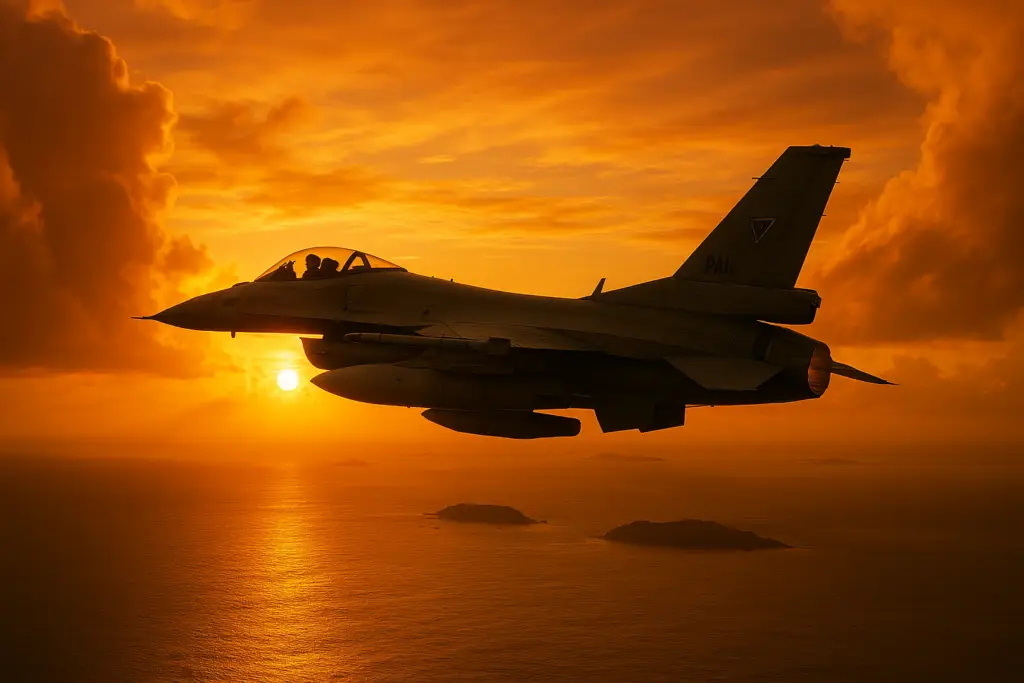In a dramatic escalation of America’s military commitment to Southeast Asia, the Pentagon has unleashed a $5.58 billion thunderbolt across the increasingly volatile South China Sea. The United States approved the sale of 20 advanced F-16 fighter jets to the Philippines on Tuesday, tripling Manila’s air combat power and sending shockwaves through Beijing’s corridors of power.
The deal transforms the Philippines from a vulnerable spectator in the region’s intensifying power struggle to an armed participant with teeth. Just days after Defense Secretary Pete Hegseth’s first Asia visit, where he vowed to counter “China’s aggression,” this massive arms transfer signals Washington’s determination to fortify what Hegseth called an “ironclad alliance” with its longtime Pacific partner.
“This proposed sale will support the foreign policy and national security of the United States by helping to improve the security of a strategic partner that continues to be an important force for political stability, peace, and economic progress in Southeast Asia,” the US Defense Security Cooperation Agency declared in its announcement.
The timing couldn’t be more significant. As Beijing’s shadow grows longer across the disputed waters of the South China Sea, the Philippines has found itself increasingly isolated on the front lines of China’s territorial ambitions. Chinese coast guard vessels regularly shadow Philippine ships, water cannons have been deployed against Filipino sailors, and artificial islands bristling with military installations have materialized across the contested waterway.
For the Philippine Air Force, currently limited to just 12 lighter South Korean-made FA-50 jets, the acquisition represents a quantum leap in capability. The package includes 16 single-seat F-16C fighters and 4 dual-seat F-16D training jets – all equipped with the latest block 70/72 technology that Lockheed Martin describes as “the world’s most advanced fourth-generation fighter.”
The numbers tell a compelling story. These supersonic warplanes scream through the skies at more than 1,500 miles per hour – a full 350 mph faster than the Philippines’ current jets. With a structural service life exceeding 12,000 hours, they represent not just a temporary solution but a generational commitment to Philippine air sovereignty.
China’s response was swift and pointed. “Any defense and security cooperation that the Philippines engages in with other countries should not target or harm the interests of any third party, nor should it threaten regional peace and security or escalate tensions in the region,” Chinese Foreign Ministry spokesperson Guo Jiakun warned on Wednesday.
In a thinly veiled accusation directed at Washington, Guo added: “As for who is fueling the flames, who is provoking military confrontation, and who is turning Asia into a powder keg, we believe that regional countries can see the situation clearly.”
The deal emerges against the backdrop of the Trump administration’s renewed focus on the Indo-Pacific region. Standing alongside Philippine Defense Secretary Gilbert Teodoro last Friday, Hegseth articulated a vision where “for the 21st century to be a free century, America needs to stand alongside our allies and partners shoulder to shoulder.”
This language of solidarity comes despite President Trump’s previous questioning of overseas military commitments, including those in Asia where tens of thousands of American troops are stationed across sprawling bases in Japan and South Korea.
For the Philippines, the F-16 acquisition represents more than just new hardware – it’s a lifeline in an increasingly dangerous neighborhood. Since 2016, an international tribunal has rejected Beijing’s expansive claims to nearly the entire South China Sea, but China has simply ignored this ruling, continuing to assert dominance over vital shipping lanes through which an estimated $3 trillion in global trade flows annually.
Military analysts note that while 20 F-16s won’t fundamentally alter the regional balance of power against China’s fleet of over 1,500 combat aircraft, they provide Manila with a credible deterrent and the ability to monitor its own territorial waters with sophisticated radar and surveillance systems included in the package.
“This isn’t about matching China plane-for-plane,” explained Dr. Richard Heydarian, a Manila-based security expert. “It’s about establishing a minimum credible defense posture that raises the cost of aggression and provides the Philippines with options beyond simply capitulating to Beijing’s demands.”
The whisper of Philippine resistance has now become a roar, amplified by American technology and backed by Washington’s strategic calculus. As the jets’ contrails will eventually streak across contested skies, they’ll carry not just Philippine pilots but the weight of America’s renewed commitment to a region it once seemed ready to abandon.
Whether this military upgrade represents a stabilizing force or another step toward confrontation in Asia’s powder keg remains the unanswered question that keeps diplomats awake at night and military planners busy at their desks.




